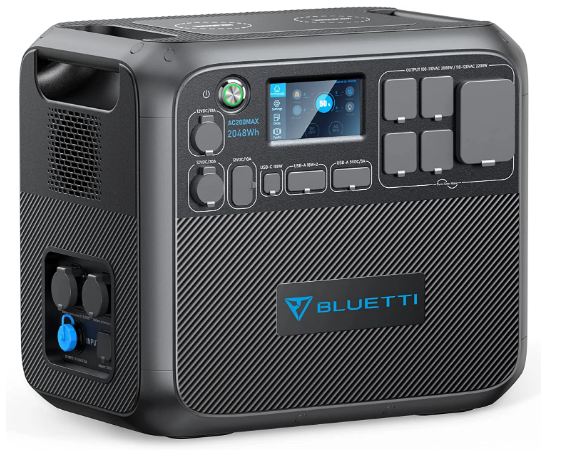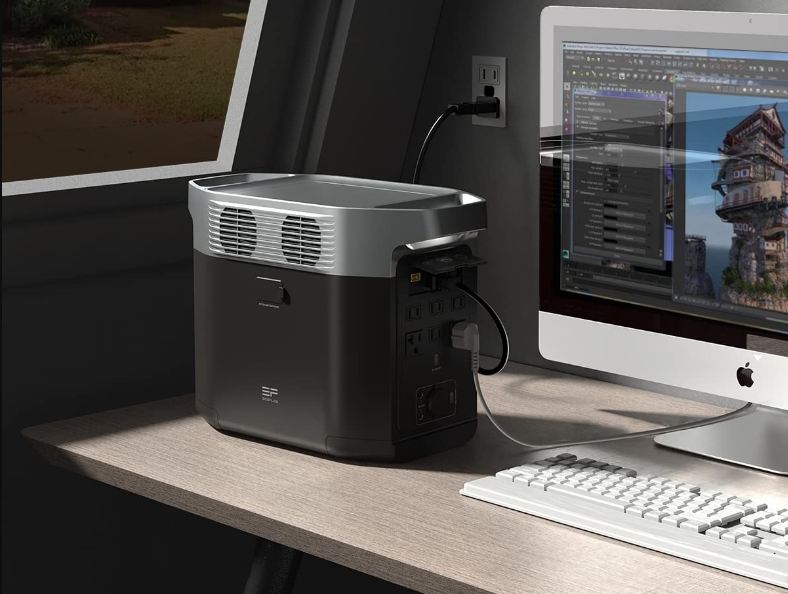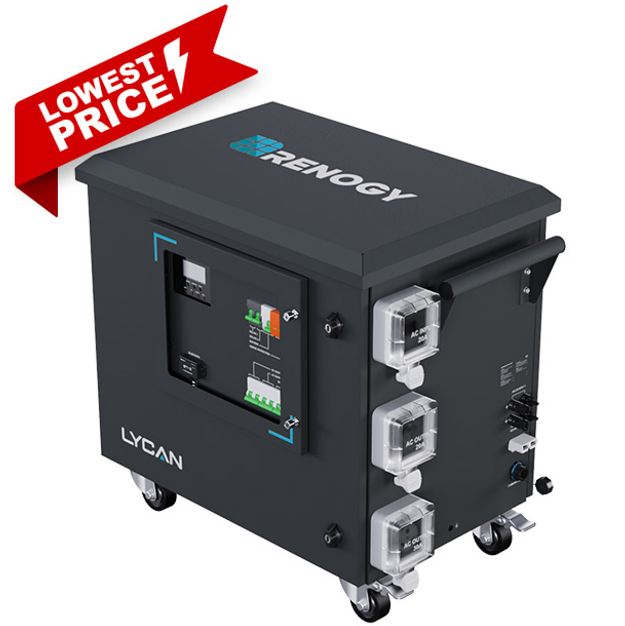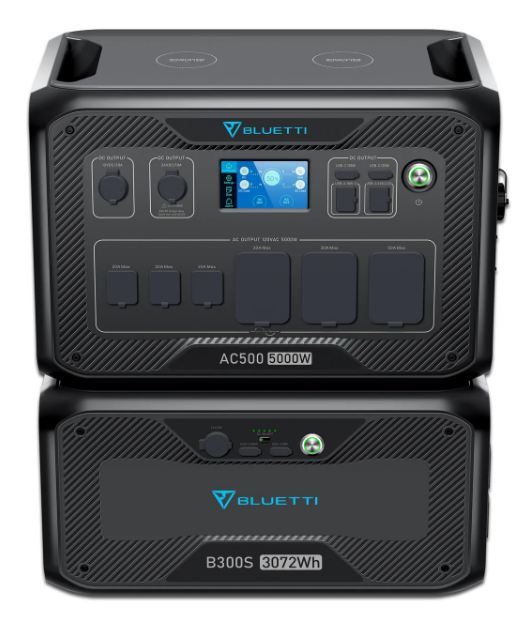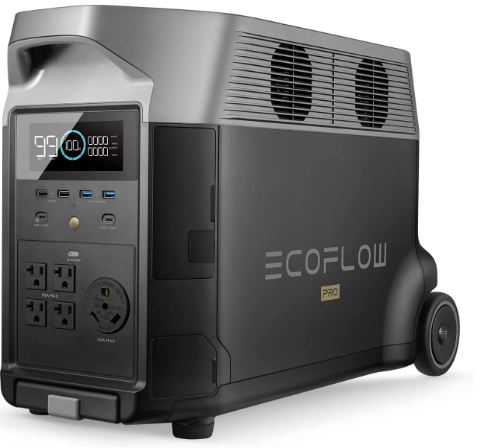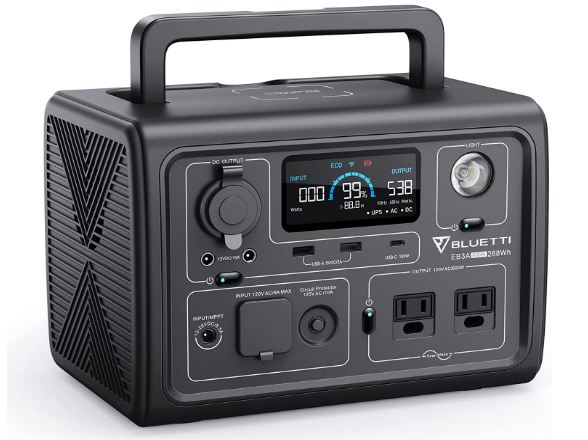Shopping for a lithium iron phosphate (LiFePO4) solar generator?
You’ve come to the right place.
Once common only in solar battery banks, LiFePO4 or LFP batteries have started to appear in solar generators, replacing lithium-ion NMC batteries.
Many brands including Bluetti, EcoFlow and Renogy now sell a range of LFP solar generators.
Why Get A LiFePO4 Solar Generator?
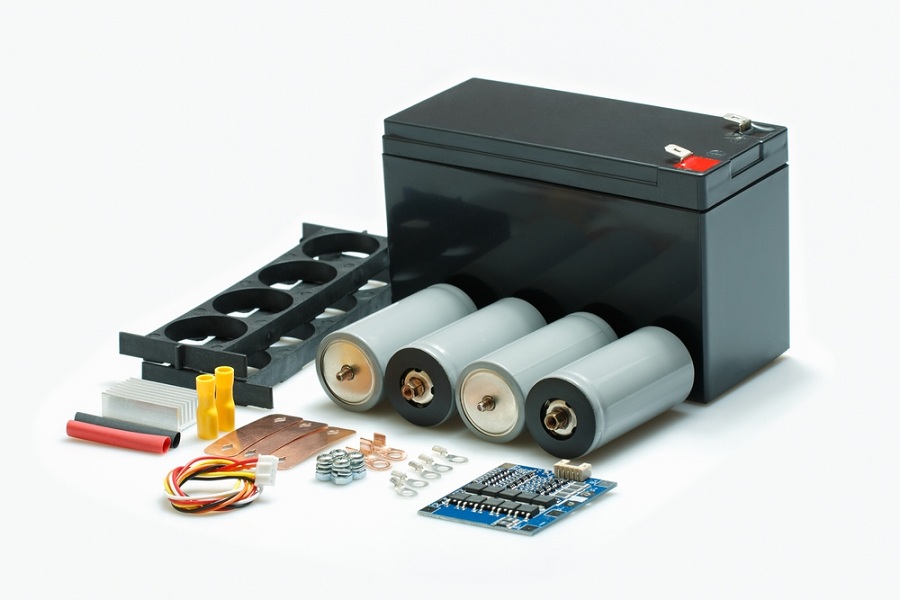
Here are the biggest advantages of a LiFePO4 solar generator.
Basically, the biggest reason to get a lithium iron phosphate solar generator is longevity. This long lifespan is especially useful if you plan to use the solar generator daily or frequently.
LiFePO4 solar generators can withstand frequent cycling (charging & discharging) and still last a long time without deteriorating too quickly.
It can take 3-5 years before a LiFePO4 power station deteriorates to 80% of its original capacity, and up to 10 years before it is unusable.
In contrast, it can take as little as 2 years for a Li-ion solar generator to drop to 80% of its original capacity (if you cycle it daily or frequently). Overall lifespan is usually under 5 years.
Read our post on the differences between lithium-ion and LiFePO4 to learn more.Best LiFePO4 Solar Generators
- 1Best Overall: Bluetti AC200MAX
- 2Best For Camping: EcoFlow Delta 2
- 3Best For Home Backup: Renogy Lycan 5000
- 4Best For Off-grid Power: Bluetti AC500
- 5Best For Boats & RVs: EcoFlow Delta Pro
- 6Best Compact: Anker 535 Portable Power Station
- 7Best Budget: Bluetti EB3A Portable Power Station
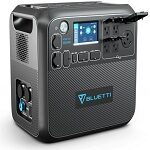
Bluetti AC200MAX
Best overall
2048Wh
3500 cycles to 80%
2200W output
62lbs
2yr warranty
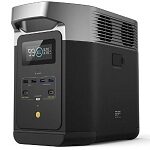
EcoFlow Delta 2
Best for camping
1024Wh
3000 cycles to 80%
1800W output
27lbs
5yr warranty
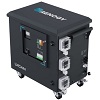
Renogy Lycan 5000
Best for home backup
4800Wh
4500 cycles to 80%
3500W output
264.4lbs
3yr warranty
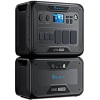
Bluetti AC500
Best for off-grid power
3072Wh
3500 cycles to 80%
5000W output
66.2lbs (AC500), 83.8lbs (B300S)
4yr warranty
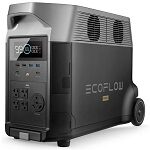
EcoFlow Delta Pro
Best for RVs & boats
3600Wh
3500 cycles to 80%
3600W output
99lbs
5yr warranty
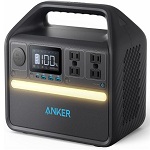
Anker 535
Best compact
512Wh
3000 cycles to 80%
500W output
16.7lbs
5yr warranty
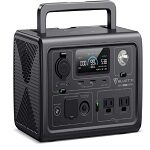
Bluetti EB3A
Best budget
268Wh
2500 cycles to 80%
600W output
10.1lbs
2yr warranty
1. Best Overall: Bluetti AC200MAX
The Bluetti AC200MAX is a great all-round LFP solar generator. Whether you want a solar generator for camping, home backup or off-grid power, the AC200MAX is fit for the task.
Pros
Cons
Our Review
The Bluetti AC200MAX’s LiFePO4 battery pack has a capacity of 2048Wh. That’s plenty for running appliances and electronics.
If you need more, you can add a pair of B230 LFP batteries to increase capacity to 6144Wh or a pair of B300 batteries to increase capacity to 8192Wh.
A maxed out Bluetti AC200MAX can easily power household appliances for days.
Bluetti claims the LFP cells used in the AC200MAX have a cycle life of 3500 cycles to 80% capacity.
Even if you drain and recharge the Bluetti AC200MAX daily, it will last almost 10 years before the battery deteriorates to 80% of the original capacity. You can still use it for years after that.
High Output
The Bluetti AC200MAX can power most of the appliances in your home or RV thanks to its high 2200W continuous output (4800W peak output).
You can even plug in multiple appliances at the same time without tripping the inverter.
What Can The Bluetti AC200MAX Power?
Here are a few of the things you can plug into the AC200MAX and how long they’ll run (assuming you only plug in that item).
TV (100W) | 17.4 hrs |
Fridge (150W) | 11.6 hrs |
Microwave (900W) | 2 hrs |
10-cup drip coffee Maker (1000W) | 17 cups |
Laptop (60W) | 29 hrs |
Smartphone (4000 mAh) | 117 recharges |
16 Outlets
The Bluetti AC200MAX has some of the most versatile output options we’ve seen in a solar generator.
For AC power, you get five options. These include four household style 120V outlets and one 120V/30A high power outlet for connecting the AC200MAX to your home grid or your RV.
For DC power, there’s the standard 12V/10A car outlet, two smaller 5.5mm 12V/10C outlets and a high power 12V/30A outlet you can plug your RV’s Anderson plug into.
To recharge your gadgets and devices, the AC200MAX has two Quick Charge USB-A ports, two regular USB-A ports, a 100W USB-C port and two 15W wireless charging pads.
Fast Recharging
The Bluetti AC200MAX recharges in no time at all.
It takes in up to 900W of solar to recharge in 2.7 hours and 400W of AC power to recharge in 4.5 hours from a wall outlet or gas generator.
You can further speed up charging by getting a second charger and plugging it into two AC outlets at the same time. This cuts down charging time to 2.5 hours.
You can also combine a wall outlet and 900W of solar at the same time to charge the AC200MAX in 2 hours.
The AC200MAX can also charge from your vehicle’s 12V outlet or from a lead acid battery, but these methods take a lot longer and are only ideal in emergencies or to top up the power station.
Issues & Limitations
If you are shopping for a highly portable LiFePO4 solar generator, we don't recommend the Bluetti AC200MAX.
At 62lbs, it is fairly heavy. You can take it with you in your RV or when truck camping. But if you plan to move it around a lot, either get a Bluetti trolley cart or pick for a lighter solar generator like the EcoFlow Delta 2.
2. Best For Camping: EcoFlow Delta 2
If you want a lightweight but capable LiFePO4 solar generator you can use when camping and other outdoor adventures, we recommend the EcoFlow Delta 2.
It weighs 27lbs and can power most appliances including large ones such as a portable electric cooker or a coffee maker.
Pros
Cons
Our Review
The Delta 2 is the first compact solar generator from EcoFlow that uses a LiFePO4 battery. Previously, only the huge 3600Wh EcoFlow Delta Pro had a LiFePO4 battery.
Despite having a heavier battery, the Delta 2 is still relatively lightweight at 27lbs. It weighs about the same as other 1kWh li-ion solar generators like the Jackery 1000 Pro.
The lightweight design combined with the compact size makes the Delta 2 perfect for outdoors and traveling. It has a rigid built-in handle to make it easy to lift and carry around.
Expandable Capacity
The EcoFlow Delta 2 has a 1024Wh LFP battery. That’s enough to power small and mid-size appliances for a few hours.
Here’s how long you can power various items (based on figures from EcoFlow).
Drone (25Wh) | 25 recharges |
CPAP (40W) | 16 hours |
Laptop (60Wh) | 16 recharges |
Coffee Maker (1000W) | 48 mins |
Mini fridge (60W) | 16-32 hrs |
Induction cooker (1800W) | 24 mins |
If you want to run appliances like an induction cooker for longer, you can expand capacity up to 3kWh.
The option to expand the Delta 2 power station is handy if you love going on extended camping trips or overlanding adventures.
1800W Output
Normally, you don't find 1kWh solar generators that can power just about any household appliance. The Delta 2’s 1800W output is uniquely high among solar generators of its capacity.
And it can get even higher. By slightly lowering the voltage used by appliances, Delta 2 can support up to 2200W of power consumption.
Technically, the EcoFlow Delta 2 doesn't produce 2200W. Instead, it tweaks appliances (using a voltage regulator) to run at a lower wattage. Appliances that would normally draw 2200W, draw less power that the Delta 2’s inverter can handle.
15 Outlets
You can connect up to 6 appliances at the same time to the 120V outlets on the EcoFlow Delta 2. You can have your fridge, fan, projector, laptop and a couple other appliances going simultaneously.
Just make sure you don't exceed 1800W combined (or 2200W with X-Boost turned on).
For 12V DC power, you have three options: a car outlet and two DC5521 outlets.
The rest are USB ports which include two USB-A, two Quick Charge USB-A and two 100W USB-C.
Fast Charging
You can charge the Delta 2 before you leave home for a 1-2 night camping trip. It takes just 50 minutes to charge to 80%, and 80 minutes total to charge to 100%.
If you are planning a longer trip, get solar panels to keep the Delta 2 charged when off-grid. It accepts up to 500W of solar to charge in about three hours.
You can also charge the Delta 2 from your vehicle's 12V output or the EcoFlow smart generator.
WiFi & Bluetooth Connectivity
You can monitor and control the Delta 2 from a smartphone app. This saves you the trouble of constantly checking the small display on the power station.
You can check power coming in, how much battery charge is left, and how much power is going out.
The Delta 2 has both Bluetooth and WiFi, so you can use the app even when you are outdoors without WiFi. It’ll switch automatically to Bluetooth if there’s no WiFi.
Issues & Limitations
The main complaint from users of the Delta 2 is that it can get noisy, which can be a problem in a small space like a camper van, truck or tent.
The fan gets especially loud when the Delta 2 is charging.
One thing you can do is lower the charging speed via the app when the Delta 2 is plugged into an AC outlet. Bring it down from the 1200W max to 500W. It will take longer to charge, but it will get less hot and the fan will be quieter.
3. Best For Home Backup: Renogy Lycan 5000
If you want to power most of the appliances and electronics in your home during a power outage, get the Renogy Lycan 5000 Power Box.
It’s a rugged solar generator with massive capacity and output.
Pros
Cons
Our Review
The Renogy Lycan 5000 doesn't have the neat compact look of most power stations. Instead, it looks bulky and rugged.
That’s because it is designed for use in a wide range of environments to provide power in emergencies, during blackouts and in off-grid homes.
Individual components - MPPT charge controller, circuit breakers, inverter etc. - are connected in a modular design inside an IP55 protected housing.
This modular design allows you to replace individual components without replacing the entire power stations - that’s great for maintenance.
Expandable Capacity
The Lycan 5000 comes with two 48V 50Ah Renogy LiFePO4 smart batteries with a combined capacity of 4800Wh.
You can connect up to 6 more of the smart LiFePO4 batteries for a total capacity of 19.2kWh, enough to back up your home for days.
High Power Output
The Lycan 5000 has a powerful output of 3500W (7000W peak). That’s probably not enough to power your entire home, but it can power a large part of your home and keep essential appliances running.
Here’s how long it can run various appliances.
Appliance | Run time |
Refrigerator (135W) | 60 hours |
TV (120W) | 34 hours |
Washing machine (500W) | 8 cycles |
Coffee maker (900W) | 90 cups |
Heater (1500W) | 2.7 hours |
Power tool (1000W) | 4 hours |
The Lycan 5000 doesn't have many outlets like most solar generators. Instead, it has just two outlets: a 20A and 30A 120V outlet.
You have two ways to power appliances.
You can use a heavy duty power strip connected to one of the outlets to power several appliances. Just check that you don't exceed the total amps for that outlet.
But the easiest option is to integrate the Lycan 5000 into your home grid. Renogy sells a transfer switch and adapter cable for connecting the Lycan to your electrical panel (make sure you get a licensed electrician to do this work).
With the transfer switch installed, the Lycan 5000 will automatically take over select circuits when there’s a blackout.
Fast Charging
The Renogy Lycan accepts up to 4400W of solar power, one of the highest solar inputs we’ve seen in a solar generator.
This recharges it in a quick 2.5 hours, ensuring you have power by the time it gets dark.
You can also charge the Lycan 5000 with 2400AC power either from a wall outlet or a gas generator.
There’s also an option to combine the two (6900W total) and charge the Lycan 500 in just 1.3 hours.
Issues & Limitations
The Lycan 5000 weighs 264.6lbs. It’s clearly not suited to camping or camper vans. If you are looking for something a bit more portable, this is not it.
Thankfully, it is wheeled so you can still move it over short distances at home.
The other issue is the lack of multiple output options. If you want a solar generator you can plug appliances and electronics directly into, pick something else.
4. Best For Off-grid Power: Bluetti AC500
If you want to power your off-grid home with a LiFePO4 solar generator, the Bluetti AC500 is a great pick. With an output of 5000W it’s one of the most powerful solar generators in the market today.
Pros
Cons
Our Review
Solar generators are slowly matching the capability of gas generators, making the switch from gas to the greener solar power stations feasible.
One of the most capable solar generators available today is the Bluetti AC500. It comes with a 5000W pure sine wave inverter. That’s powerful enough to power a small to midsize home or an entire RV.
If you have 240V wiring or have some 240V appliances like a dyer or well pump, you can get a second AC500 and set up a 240V split phase system with an output of up to 10,000W.
Massive Capacity
To support the high output, the Bluetti AC500 comes with a 3,072Wh LiFePO4 battery pack. It’s actually a separate unit called the B300S.
Here’s how long the B300S battery can run various appliances.
CPAP (40W) | 65.2hrs |
Mini fridge (60W) | 43.52hrs |
Full size refrigerator (300W) | 8.7hrs |
Laptop (60Wh) | 43 recharges |
Microwave (700W) | 3.7hrs |
AC (1800W) | 1.4hrs |
If the 3kWh capacity is not enough for your needs, you can order five additional B300S units to boost capacity to 18,432kWh.
Plenty of Outlets
If you prefer running appliances directly off the Bluetti AC500, it comes with three 120V/20A AC outlets.
There are also three additional high power 120V outlets (two 30A and one 50A) for large appliances or to connect the AC500 to your RV or home electrical panel.
You can also plug a boat into one of the high power outlets.
DC power is available via a 24V/10A car outlet, a 12V/30A RV port and an extra 12V/10A car port on the B300S battery pack.
For devices, you get six USB ports (USB-A and 100W USB-C), two wireless charging pads and two additional USB ports on the B300S unit.
Quick Recharging
The AC500 accepts an impressive 3000W of solar power, which charges it in 1.5-3 hours.
AC input from a wall outlet or solar generator is even higher at 4500W, which goes up to 8000W if you have at least two B300S battery packs connected to the AC500.
Other charging options include dual solar + AC, a lead acid battery and your vehicle’s 12V outlet.
Issues & Limitations
The AC500’s huge power output and capacity don’t come cheap. If you are shopping for a budget off-grid LiFePO4 solar generator, look for an alternative. We recommend the Bluetti AC200MAX.
5. Best For Boats & RVs: EcoFlow Delta Pro
Looking to power your RV or boat with a LiFePO4 solar generator? We recommend the EcoFlow Delta Pro.
It doesn't take up too much space in your vehicle and it’s powerful enough to power most or all the appliances in the RV.
Pros
Cons
Our Review
You can get the EcoFlow Delta Pro as the main power source for your RV, boat or campervan.
The 3600W output and 3600Wh capacity is plenty enough to power multiple appliances at the same time.
You can also use the Delta Pro to complement your RV’s regular power system. It can help take the load off your RV’s battery bank and inverter.
Expandable Capacity
The 3600Wh LiFePO4 battery that comes with the Delta Pro is already big. But if you need more capacity, there’s an option to expand it to 25kWh.
You can build up enough capacity to power your RV or boat for days even without recharging. This is great for extended boondocking trips.
120V/240V Output
The 3600W output runs multiple appliances without a problem. You can even power large items like AC or an electric cooker.
Here’s how long the Delta Pro battery lasts when powering various appliances and electronics.
Microwave (1300W) | 2.5 hrs |
Washer (500W) | 6.5 hrs |
Fridge (120W) | 24 hrs |
Coffee maker (1000W) | 3.3 hrs |
Laptop (60Wh) | 67 recharges |
CPAP (40W) | 50 hrs |
The Delta Flow has a 240V split phase option that doubles max output to 7200W. Use this to run a 240V RV or any 240V appliances you have such as an air conditioner.
Note that you’ll need a second unit to set up 240V output.
Easy Shore Power Connection
You don't need to do any wiring to power your boat or RV with the EcoFlow Delta Pro.
It comes with the same 120V/30A shore power outlet you find in many RV parks and campsites. Just plug in your RV’s 30A cord into the outlet and you are good to go.
There’s also a 12V/30A output you can use to power your RV’s 12V system.
Other outputs include four AC outlets, six USB ports (USB-A & USB-C), a 12V/10A car port and two DC5521 DC outlets.
Versatile & Fast Recharging Options
You can recharge the EcoFlow Delta Pro five different ways.
Plug it into a wall outlet (1800W input, 2.7hrs recharge time), use solar panels (1600W max input, 2.8-5.6hrs recharge time), use a level 2 EV charger (3400W, 1.7hrs recharge time), use the EcoFlow smart generator (1700W input), or combine AC, solar and the smart generator (6500W input, less than 2hrs charge time).
Issues & Limitations
Like many high-output and fast-charging solar generators, the EcoFlow Delta Pro sometimes gets noisy.
This usually happens when you draw a lot of power or you charge it at high speeds. It heats up and the fan has to work harder to cool the power station.
6. Best Compact: Anker 535 Portable Power Station
Shopping for a compact and lightweight LiFePO4 power station? The 16.7-pound Anker 535 is one of our most favorite small LFP solar generators.
It’s great for camping, road trips, and home backup for devices and small appliances.
Pros
Cons
Our Review
It’s a bit difficult to find small solar generators with LFP batteries. Most use Li-ion NMC batteries to keep the weight low (since most of these generators are designed to be easily portable).
But compact LiFePO4 solar generators are starting to appear, and the Anker 535 is one of the best ones around.
The Anker 535 has a capacity of 512Wh and a continuous output of 500W, making it suitable for powering small appliances and recharging devices.
Here’s the approximate battery life when powering various items.
Phone (12Wh/3200mAh) | 33 recharges |
Drone (40Wh) | 10.2 recharges |
Fan (35W) | 11.8 hrs |
Mini fridge (40W) | 10.4 hrs |
Air pump (40W) | 10.4 times |
Laptop (60Wh) | 7 recharges |
Multiple Outlets
The Anker 535 power station has nine outlet ports.
These include four AC outlets for small appliances, a 12V car socket, three USB-A ports and an in/out 60W USB-C port.
Fast Charging
Max solar input into the Anker 535 is 120W. This may seem low but remember the capacity is just 512Wh.
120W is enough to get it to 80% in four hours.
For AC charging, combine the included AC adapter with a USB-C charger to achieve an input of 180W and charge the Anker 535 in just 2.5 hours.
You can also charge the Anker 535 from your car socket when on the road.
Issues & Limitations
If you want a LiFePO4 solar generator that can handle appliances like a coffee maker, refrigerator, microwave and other high-wattage items, don't get the Anker 535.
That’s why we don't recommend it for home backup or off-grid power (unless you plan to only power small appliances and electronics).
7. Best Budget: Bluetti EB3A Portable Power Station
The Bluetti EB3A is another excellent choice if you are shopping for a compact LFP solar generator. It’s also a great pick if you are shopping on a budget.
Pros
Cons
Our Review
The Bluetti EB3A is one of the cheapest LFP solar generators you’ll find. It’s also one of the smallest LFP power stations with a capacity of just 268Wh.
It’s a great pick if you want a small LiFePO4 solar generator for small appliances like a car fridge, CPAP, or a small fan. It’s also ideal for charging/powering electronics like a laptop, phone, TV and so on.
Power output is 600W, which is surprisingly high for a solar generator of this capacity. While that’s enough power for some sizable appliances like a mini drip coffee maker or travel electric cooker, these appliances will drain the battery too quickly.
So we recommend sticking to small items. Here’s how much runtime to expect with various appliances and electronics.
Electric blanket (120W) | 1.9 hrs |
Projector (100W) | 2 hrs |
Router (10W) | 20 hrs |
CPAP (40W) | 5 hrs |
Smartphone (10Wh) | 20 recharges |
9 Outlets
The Bluetti EB3A has a couple of AC outlets, which are enough considering its limited capacity.
There are three DC ports including a 12V car port and two DC5521 outlets. You also get three USB ports — two USB-A and one 100W USB-C. There’s also a wireless charging pad.
Fast Charging
The EB3A accepts up to 200W of solar, which charges it in 2 hours. You can also plug it into a wall outlet or combine both solar and AC to recharge it in about one hour.
Car charging takes 3.3 hours, so you can easily recharge the EB3A while on the way to your campsite.
Issues & Limitations
The Bluetti EB3A is greatly limited by its 268Wh capacity. Even with small appliances like a CPAP, it only provides a few hours of runtime.
If you want a compact solar generator that can power small appliances for longer, we recommend the Anker 535 instead.
What To Look For When Buying A LiFePO4 Solar Generator
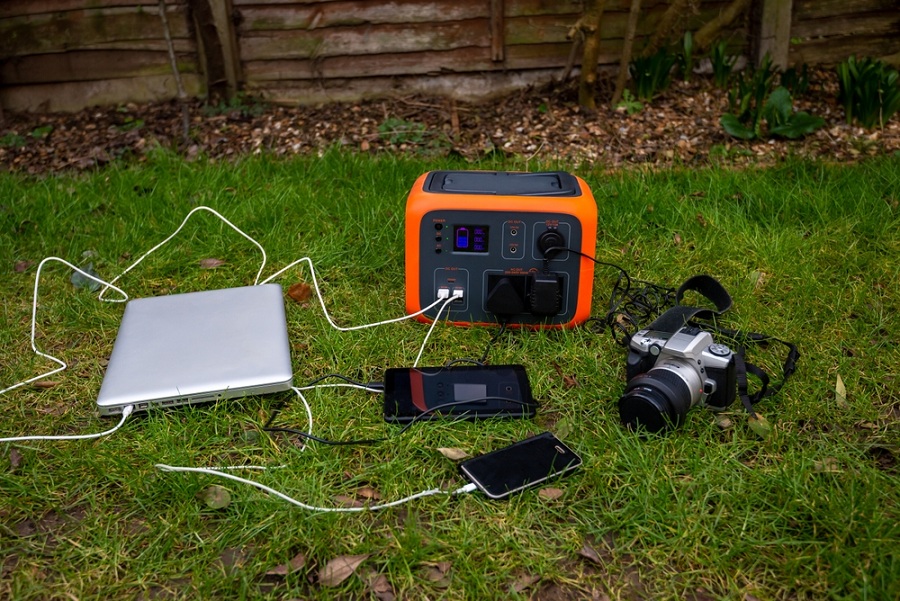
Capacity
The first step is to make sure that you are actually buying a LiFePO4 solar generator. Check the description to make sure it mentions a LiFePO4 or LFP battery.
If it just says lithium-ion (li-ion) or lithium battery, that’s probably not a LiFePO4 battery.
Next, decide how much capacity you want.
If you are getting a solar generator for home backup or off-grid power, get one with a minimum capacity of 2000Wh.
It’s also a good idea to get one that is expandable just in case you need additional capacity in the future.
For camping, road trips and other situations where you don't need to run large appliances, a 1000Wh or less solar generator will do.
Power Output
The power output from a LiFePO4 solar generator determines which appliances you can run and how many you can power at the same time.
Usually, if you need a lot of capacity, you probably also need lots of power. So if you are getting a home backup or off-grid solar generator, get one with minimum 2000W output.
If you want to power most of your home, get a 3000+ watt solar generator.
If you only need to power small appliances and charge electronics, a 1000W or less solar generator is adequate.
Something else to look for, especially if you are getting a powerful solar generator, is 240V split phase output.
This feature is useful if you have any 240V appliances.
Outlets
Check the type and number of outlets that a solar generator has.
You should get at least three AC outlets, three USB ports and one or two DC ports.
If you are getting a large solar generator for backup or off-grid power, look for one with high-power 30A or 50A outlets. These allow you to connect the solar generator directly to your home or RV.
When it comes to the USB ports, we recommend getting a solar generator that offers Quick Charge (18W) USB-A ports and 60W or 100W USB-C ports.
As for the DC ports, a 12V car outlet is usually enough. But having a couple of DC5521 (5.5mm) outlets can also be handy for powering small 12V electronics.
Charging Performance
One of the biggest advantages of buying a LiFePO4 solar generator is the charging performance. LiFePO4 batteries charge really fast.
You’ll find that even large-capacity solar generators like the Renogy Lycan can recharge in 2-4 hours.
Don’t get a solar generator that takes more than 5 hours to recharge via AC or solar. Fast solar charging is especially important for off-grid or backup solar generators.
Portability
LiFePO4 solar generators tend to be heavier than similar size Li-ion power stations. So check just how heavy a particular solar generator is before you order it.
This is especially important if you are getting a solar generator for camping or outdoor use. We recommend getting one that’s no heavier than 30lbs.
For large home backup/off-grid solar generators, you have to make do with a heavy solar generator. But make sure it is wheeled for easy mobility around your home.
Pros & Cons of LiFePO4 Solar Generators
Pros
Cons
FAQs
Is Jackery a LiFePO4 solar generator?
Currently, Jackery doesn't sell any LiFePO4 solar generators. Their power stations use Li-ion NMC batteries.
Which companies sell LiFePO4 solar generators?
EcoFlow, Bluetti, Renogy, Anker and Zendure are some of the companies that manufacture and sell LFP solar generators.
Which is better between a LiFePO4 and lithium-ion solar generator?
A LiFePO4 solar generator is overall better than lithium-ion simply because of its incredible longevity. LiFePO4 solar generators last 2-3 times as long as Li-ion solar generators.
However, if you are shopping for an ultra-portable solar generator, a li-ion power station is your best choice. Li-ion solar generators are lighter than LFP.
How many years do LiFePO4 solar generators last?
LiFePO4 solar generators last between 5 and 10 years before capacity permanently drops to 80% of the original. But you can still keep using the solar generator long after that.

